Related Research Articles

The brush-tailed rock-wallaby or small-eared rock-wallaby is a kind of wallaby, one of several rock-wallabies in the genus Petrogale. It inhabits rock piles and cliff lines along the Great Dividing Range from about 100 km north-west of Brisbane to northern Victoria, in vegetation ranging from rainforest to dry sclerophyll forests. Populations have declined seriously in the south and west of its range, but it remains locally common in northern New South Wales and southern Queensland. However, due to a large bushfire event in South-East Australia around 70% of all the wallaby's habitat has been lost as of January 2020.

The black-tufted marmoset is a species of New World monkey that lives primarily in the Neotropical gallery forests of the Brazilian Central Plateau. It ranges from Bahia to Paraná, and as far inland as Goiás, between 14°S and 25°S, and can commonly be seen in the Rio de Janeiro city where it was introduced. This marmoset typically resides in rainforests, living an arboreal life high in the trees, below the canopy. They are only rarely spotted near the ground.
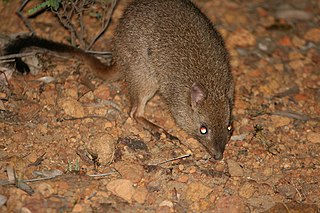
The woylie or brush-tailed bettong is a small, critically endangered mammal native to forests and shrubland of Australia. A member of the rat-kangaroo family (Potoroidae), it moves by hopping and is active at night, digging for fungi to eat. It is also a marsupial and carries its young in a pouch. Once widespread, the woylie mostly died out from habitat loss and introduced predators such as foxes. It is currently restricted to two small areas in Western Australia. There were two subspecies: B. p. ogilbyi in the west, and the now-extinct B. p. penicillata in the southeast.
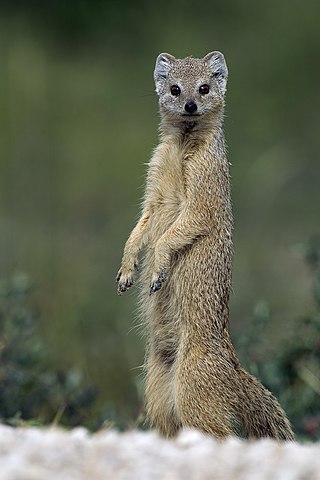
The yellow mongoose, sometimes referred to as the red meerkat, is a member of the mongoose family. It averages about 0.45 kg (1 lb) in weight and about 510 mm (20 in) in length. It lives in open country, semi-desert scrubland and grasslands in Angola, Botswana, South Africa, Namibia, and Zimbabwe. It is the only species in the genus Cynictis.

Copaene, or more precisely, α-copaene, is the common chemical name of an oily liquid hydrocarbon that is found in a number of essential oil-producing plants. The name is derived from that of the resin-producing tropical copaiba tree, Copaifera langsdorffii, from which the compound was first isolated in 1914. Its structure, including the chirality, was determined in 1963. The double-bond isomer with an exocyclic-methylene group, β-copaene, was first reported in 1967.
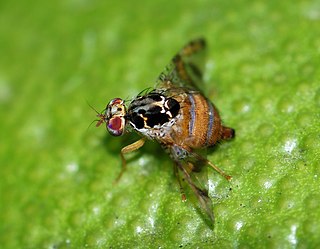
Ceratitis capitata, commonly known as the Mediterranean fruit fly or medfly, is a yellow-and-brown fly native to sub-Saharan Africa. It has no near relatives in the Western Hemisphere and is considered to be one of the most destructive fruit pests in the world. There have been occasional medfly infestations in California, Florida, and Texas that require extensive eradication efforts to prevent the fly from establishing itself in the United States.

Banksia conferta, commonly known as the glasshouse banksia, is a species of shrub that is endemic to eastern Australia. It has rough bark on the trunk, elliptic to egg-shaped leaves arranged in whorls, and crowded yellow flowers in a cylindrical spike later forming a relatively large number of follicles.

Bursera is a genus with about 100 described species of flowering shrubs and trees varying in size up to 25 m (82 ft) high. It is the type genus for Burseraceae. The trees are native to the Americas, from the southern United States south through to northern Argentina, in tropical and warm temperate forest habitats. It is named after the 17th-century Danish botanist Joachim Burser.
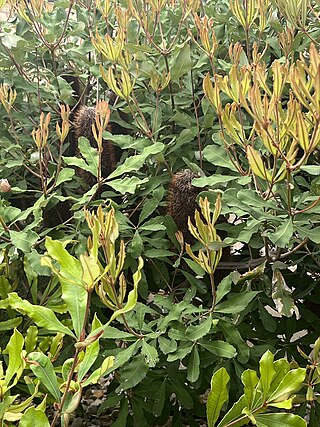
Banksia penicillata is a species of shrub that is endemic to a restricted area of New South Wales. It has smooth bark, serrated, elliptic to egg-shaped leaves, green to bluish flower buds, later yellow flowers in a cylindrical spike, and later still, up to one hundred narrow elliptical follicles in each spike, surrounded by the remains of the flowers.

Ceratitis is a genus of tephritid fruit flies with about 80 species. One of the best known species is Ceratitis capitata, the Mediterranean fruit fly.

Bettongs, species of the genus Bettongia, are potoroine marsupials once common in Australia. They are important ecosystem engineers displaced during the colonisation of the continent, and are vulnerable to threatening factors such as altered fire regimes, land clearing, pastoralism and introduced predatory species such as the fox and cat.

The grey-headed tanager is a widely distributed species of small Neotropical bird in the tanager family Thraupidae. It is the only member of the genus Eucometis.
Fruit fly may refer to:
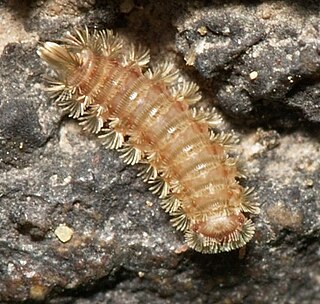
Polyxenida is an order of millipedes readily distinguished by a unique body plan consisting of a soft, non-calcified body ornamented with tufts of bristles. These features have inspired the common names bristly millipedes or pincushion millipedes. This order includes about 148 species in four families worldwide, which represent the only living members of the subclass Penicillata.
Ceratitis rosa, or commonly known as the natal fruit fly, is a fruit fly species from the family Tephritidae of the order Diptera. It is considered a pest in both its native and non-native habitats. It prefers subtropical or temperate climates and the fruits that are native to these areas. It is also capable of surviving in less dry climates compared to its relative, the Ceratitis capitata which is more specific in its habitats, described by Anton Ferdinand Karsch in 1887 in Delagoa Bay, Mozambique. Not long after in 1900, the natal fruit fly was a recognized pest for orchards and fruit farmers throughout KwaZulu Natal Province, Republic of South Africa.
A micropyle is a pore in the membrane covering the ovum, through which a sperm enters. Micropyles are also found in sporozoites of some digenetic microorganisms such as Plasmodium at the anterior part of the cell that ultimately leads towards the apical cap. Examples of other organisms that have micropyles are the Bombyx mandarina and the Ceratitis capitata.
Ceratitis ovalis is a species of tephritid or fruit flies in the family Tephritidae. It is known from Sierra Leone.
Ceratitis flexuosa is a species from the kingdom Animalia, family Tephritidae. This is a genus of Tephritid or fruit flies.
Ceratitis aliena is a species of insect in the family Tephritidae. This is a genus of Tephritid or fruit flies.

Caldoramide is a pentapeptide isolated from the cyanobacteria Caldora penicillata. It has cytotoxic effects on cancer cells and has been the subject of extensive oncological research. It is structurally analogous to belamide A and dolastatin 15. Its appearance is that of a powdery, white, substance.
References
- ↑ "Ceratitis (Pterandrus) penicillata Bigot, 1891". Catalogue of Life. Retrieved 7 November 2024.